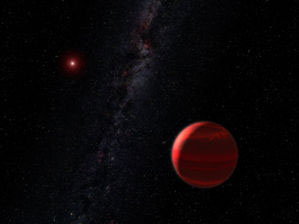 An artists conception of a planet orbiting a red dwarf star Is it just me, or have we seen a ton of astronomy news coverage in the last month? Lately, it seems like every time I check my inbox, there is a new question from my parents about some great new discovery with a link to the news article.
An artists conception of a planet orbiting a red dwarf star Is it just me, or have we seen a ton of astronomy news coverage in the last month? Lately, it seems like every time I check my inbox, there is a new question from my parents about some great new discovery with a link to the news article.
The latest burst of astronomy activity began with the discovery of a possible earth-like and earth-sized planet. This discovery came as part of one of those planet searches that both my fellow blogger Ben Burress and I have written about. Just like most of the 200 or so planets that have been discovered, this planet was found by observing the wobble of the central star.
In this case, the star was a red dwarf, a kind of star cooler and less massive than our Sun. The planet orbiting the star was much smaller than most known extrasolar planets, only about 5 times the size of Earth.
The small size of the star actually makes it easier to detect smaller planets. Each passing orbit of the planet causes a relatively large tug on the star compared to the effect of that planet on a much larger star. It’s like watching a 4-yr old swing Nick Swisher's baseball bat. The aspect of this discovery that warrants an article in the New York Times is the fact that the surface temperatures of this newly discovered planet may be quite similar to those on Earth, making it a possible environment for life. No other known extrasolar plant seems to fit this bill.
My parents' next astro-email was a couple of weeks later, following the discovery of the brightest supernova ever observed. Now, I haven't quite covered the realm of supernovae, but I hinted at it in my last post. There are several kinds of supernovae, each kind exploding for a different reason, and each kind exploding with a different brightness.
